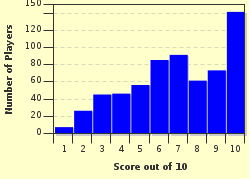Quiz Answer Key and Fun Facts
1. It is possible to work out the notes of any named musical scale or mode based on music theory.
What is the correct formula for deciphering the notes of any Major scale, starting with the first note of the scale, where T1/2= a tone and a half, T= a tone, and S= a semitone?
2. Every key signature can refer in particular to two scales, the major scale and its relative minor. What is the relative minor key for Db major?
3. Tonicization is when a pitch varying from the overall tonic is used temporarily as the tonal centre. What exactly is a tonicized chord?
4. Sometimes in a score a dot can appear above (or below) the note heads. This method of playing notes is called staccato. How might a musician play a staccato note?
5. There are tons of different chords in music, all with very specific names pertaining to the notes they possess. These names can be worked out logically.
What would be the most accurate name for an A chord consisting of the notes A, B, and Eb?
6. By which other name might the the Phrygian dominant scale known?
7. What would the instruction 'Vivacissimo' be telling the musician to do?
8. Some time signatures can be used for reasons that deviate from merely indicating beats per bar and the type of beat. The most elementary of these is 8/8 time, but why might this time signature differ so much from others such as 4/4 and 2/4?
9. A semi-quaver is the British name for the American sixteenth note.
What is the British name for the American hundred twenty-eighth note?
10. The note heads used on manuscript derived from a system of notation known as 'Neumes' around the year 600 AD. What sort of music would have been written using neumes?
Source: Author
squallen
This quiz was reviewed by FunTrivia editor
ertrum before going online.
Any errors found in FunTrivia content are routinely corrected through our feedback system.

